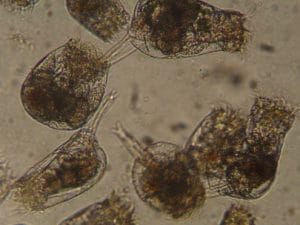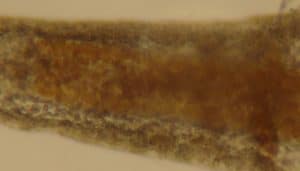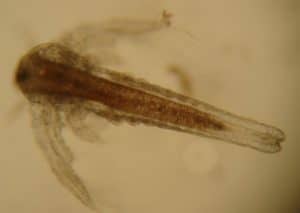Why do Marine Fish Hatcheries need to enrich live food?
12 April 2019
The success of Marine Fish larvae culture is based to a large extent on the use of rotifers and Artemia.
These live preys lack n-3 HUFA that are considered essential fatty acids (EFA) for fish larvae.
EFA must be supplemented to the live food ensure successful survival, growth and metamorphosis of the larvae.
Fish larvae have a limited ability to synthesize Phospholipids (PL) de novo and, therefore, have dietary requirements for intact PL.
This may not be surprising in marine fish larvae which, in their natural environment, ingest live food whose lipid is predominantly PL.
The major brain PL are phosphatidylcholine (PC), phosphatidylethanolamine (PE) and phosphatidylserine (PS) (Sargent et al., 1999).
These PL (PC, PE and PS) have a EFA composition similar the Eicosapentaenoic Acid (EPA) and Araquidonic Acid (AA) of the diet (Sargent et al., 1999).
Phosphatidylinositol (PI) have constant levels of EPA and AA. PL of non-enriched live food is deficient in Docosahexaenoic Acid (DHA) and EFA in general.
PL of fish larvae fed live food enriched with Triacylglicerol (TG) rich in DHA contain normal amounts of DHA.
The n-3 HUFA composition of PL in the larvae reflects those of the dietary TG (Sargent et al., 1999).
Larval growth and survival improves with addition of PL in the diets. The main responsible PL for this are:
- Phosphatidylinositol (PI) that promotes survival;
- Phosphatidylcholine (PC) that promotes growth
These PL are important for the transport of TG from the intestinal mucosal cells into the lymph and thence into the serum as Chylomicra and Very Low Density Lipoproteins (VLDL).
Dietary PL (eg lecithin) also has an effect on lipid absorption. In addition, feeding larvae with marine PL reduces lipid accumulation in tissues (Izquierdo et al., 2000).
After they are absorbed, EFA are acting as:
DHA: proper development of neural tissues (Bell et al., 1999; Sargent et al., 1999), with the highest concentrations of this EFA are found in neural and visual cell membranes.
If not sufficient it provokes a reduced “predation efficiency”, because of the impaired neural and visual development.
In flatfish abnormal pigmentation can be substantially improved if not rectified by enhancing the level of DHA in the larvae’s live feed (Sargent et al., 1999).
DHA is known to have higher efficiency as an Essential Fatty Acid than EPA (Izquierdo et al., 2000).
EPA: is also a precursor for Eicosanoid formation, and is usually much more abundant in fish tissues than AA (Bell et al., 1999).
The uncertainty relates not only to the role of EPA as a major constituent of the “structural” PL of cell membranes, but to its involvement in producing eicosanoids (3-series prostanoids and 5-series leukotrienes) (Sargent et al., 1999).

AA: is the precursor of a wide variety of biologically active compounds, known collectively as Eicosanoids.
AA derived Eicosanoids have a wide range of functions, including control of fluid and electrolyte fluxes, the cardiovascular system, reproductive function and the control of the neural system (Bell et al., 1999).
AA is an EFA for marine fish, and may well be a quantitatively minor constituent of marine fish oils, but is an important constituent that deserves as much consideration as DHA and EPA (Sargent et al., 1999).
Given the low levels of AA in commercially available fish oils, excess of AA is not a problem of marine fish larval culture (Sargent et al., 1999).
Eicosanoids: are a range of highly active C20 compounds. In broad terms they are produced in response to stressful situation, both at a cellular and whole body level.
The major source of the EFA (n-3 HUFA) for live food supplementation has been fish oils, whose contents in DHA and EPA can vary substantially (Sargent et al., 1999).
Enrichment with HUFA involves exposing the live food in seawater to micelles of TG oils stabilized with emulsifiers such as lecithin, these micelles being filtered by the live food and retained largely as TG.
The ingested supplemented oil is at least partially assimilated by intestinal mucosal cells, rather than merely remaining unassimilated and unchanged in the gut cavity.
Normal practice is to expose the live food to a given emulsion for periods between 4 and 24h so as to maximize the levels of ingested oil in the nauplii (Sargent et al., 1999).
Nevertheless, supplementing the live food with commercial fish oils containing only moderate levels of n-3 HUFA should be discouraged and, apart possibly from specialty oils such as tuna orbital oil, emphasis should transfer to using highly purified preparations of DHA, EPA and, where necessary, AA, preferably as TG (Sargent et al., 1999).
At the same time upper limits and relationships between EFA are also known (Mourente et al., 1999; Izquierdo et al., 1992 and 1999).
The link between nutrition and malformations has been difficult to demonstrate because marine larvae are fed on live prey and the nutritional composition of the live organisms cannot be easily manipulated (Zambonino et al., 2005 – Aqua Feeds).
The same authors state that it is becoming clear that dietary factors such as proteins, lipids and vitamins act on developmental processes that affect the morphogenesis of fish larvae.
BernAqua products are developed base on these scientific data/knowledge.
Because we know that fish growth and development will depend on early life stages, we put all our effort to give a boost right at the start.
In the Table below we can see a comparison of results in deformities in a 25M juvenile Hatchery using BernAqua and Competitor Products for enrichment.

| Products | Nr Cycles Produced | Production
(million fry/cycle) |
AVG Temp | Rotifer
Enrichment |
Artemia
Enrichment |
AVG %
Deformities |
| COMPETITOR | 6 | 3.325 | 20°C | COMPETITOR | COMPETITOR | 16.5% |
| BERNAQUA | 2 | 2.375 | 21.6°C | Red Pepper | Red Pepper | 11% |
Table 1: deformities in sea bream when leaving the hatchery at 1-2g.
We can clearly see a significant reduction in the deformities after the changes to BernAqua Enrichment Products in the live food, with 16.5% (COMPETITOR) to 11% (BernAqua).
If you want to ensure proper levels of EFA in your live preys, don’t hesitate to ask us for more information.


